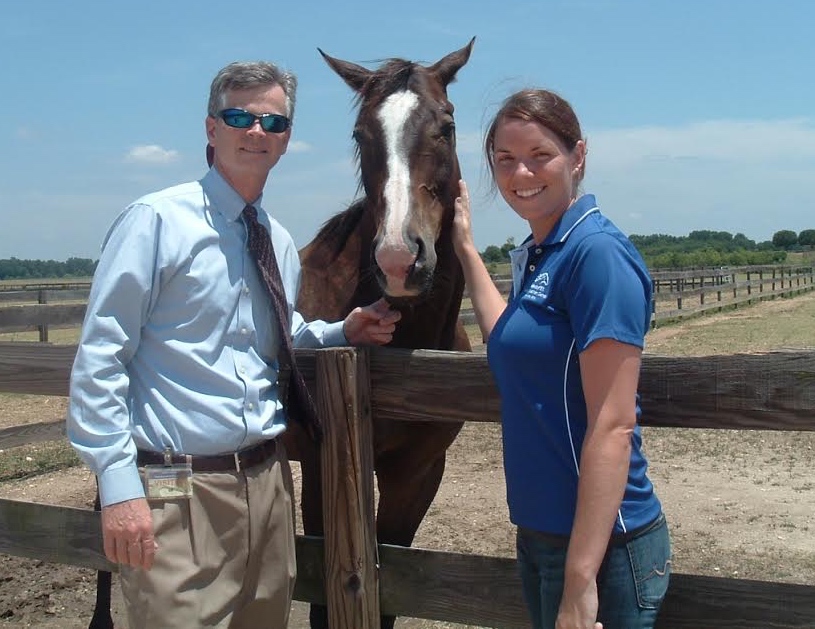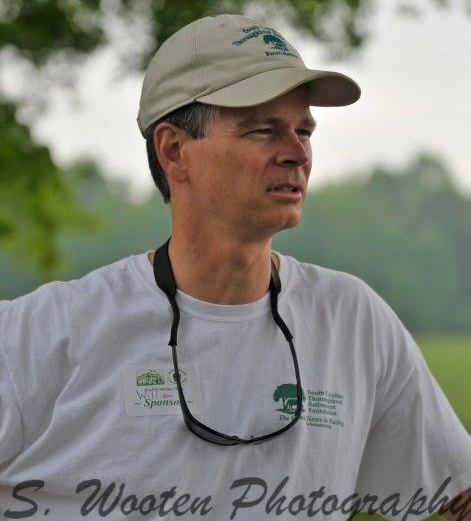
William Cox, chairman of the Thoroughbred Retirement Foundation’s Second Chances program Wateree Correctional Facility joins TRF herd manager Sara Davenport at the fence line.
William Cox freely admits he’s one of “those people” who really was raised in a barn. And all these years later, after college, law school, and launch of a successful legal career, it is in the barn where he has witnessed daily miracles proving that second chances really do work.
“I’ve seen inmates come in here who have no skills, no relationships, broken homes—the don’t have anything or anyone. And then they build a relationship with a horse, and it has a profound effect on them,” says Cox, chairman of the Thoroughbred Retirement Foundation’s (TRF) program for inmates and retired racehorses. “There are guys who come out the other side of our program a whole different person.”
As a founding member of the TRF’s Wateree River Correctional Institution’s Second Chances program in South Carolina, Cox has seen men hardened by life, soften, as their work with the animals bring deep benefits to both horse and man.
In this week’s Clubhouse Q&A, Cox discusses his enduring belief in a program that has helped men and horses rebuild their lives.
Q: What’s an attorney specializing in real estate and estate planning doing working with prisoners and horses?

Arrington Walker, pictured with her OTTB, introduced her son to horses and barn life at an early age. Photo by William Morgan “Billy” Benton
I grew up with a mother (75-year-old Eventer Arrington Walker) who was bitten with the horse bug, and as a boy we were out at the farm every weekend. I grew up doing small-level, combined training events, fox hunting and local shows. So, you know when people ask if you ‘grew up in a barn?’ Well, I really did.
In fact, in the four months between college and law school I worked at a dude ranch in Wyoming, helping scared dudes from NYC in big river crossings and overnight trips through Big Horn Mountain.
When I moved to Camden, S.C., I did a little foxhunting here, and the warden of Wateree was an acquaintance of mine. I started with the Wateree Second Chances program at its inception in 2002/2003, meeting at the warden’s kitchen table and figuring out how we were going to raise the money to get it started.
Q: Research seems to indicate it was a sound decision to teach inmates horsemanship skills in a program benefitting retired Thoroughbred racehorses.
Inmates who pass through the TRF Second Chances program have a recidivism rate of 12 percent, according to official records of our current warden. That compares to about 40 percent of the general prison population who are likely to reoffend once they’re paroled.
Q: Why do you suspect there’s a lower recidivism rate among Second Chances graduates?

Christopher Griffin, a former inmate who participated in the Thoroughbred Retirement Foundation’s Second Chances program at Wateree River Correctional Institution, now works at a top hunter/jumper and dressage facility in Georgia. Horses helped change his life.
I firmly believe that for the men who really immerse themselves in the program, that horses become the engines that drive them to change their lives. The relationships they form with those 1,200 animals become the catalyst of change.
There are guys who come in just to get outside. But there are definitely men who are curious and ask me questions and ask about guys who got out. When they, to use a horse term, ‘take the bit’ and they immerse themselves, they come out of the other side a whole different person.
Q: For many reasons, not just the altruistic, you believe this change is crucial.
These men are not choirboys, but the thing to keep in mind is that they’re all going to get out. And we need to change them. My mentor and the former treasurer of the TRF, John Rainey, was very pragmatic in realizing that helping the OTTBs in their retirement was half the goal. The other half was helping to prepare the men for life beyond the razor wire. This program really is a mutual benefit for both animals and men.
Some people have a “lock ‘em and throw away the key” mentality. People don’t want to seem like they’re spending money on criminals. But with this level of inmate, they’re getting out. And if they get out with the same attitude, or worse, that’s only going to mushroom the problem.
Q: Instead of returning to a bad path, you’ve seen men go on to obtain jobs after prison.
Chris Griffin is a former Wateree inmate who got out and went to work for a 10-stall dressage barn. Another guy, Scott, just started working for a pharmaceutical software company. (Please look for a story soon in Off-Track Thoroughbreds.com). And then there’s another inmate who was recently denied parole. These three men are among the very best men I’ve known come through the Second Chances program.
Q: You’re calling out a man who was denied parole as among the best. Please explain.

Thoroughbreds graze at the Wateree Correctional Institution where many prisoners have been learning deeb, abiding life lessons since the early 2000s.
This prisoner came up for parole in fall 2015, and was due to get out. If all the paperwork had gone through positively, he’d have been released around Christmastime. I fully expected him to be released and was shocked when he was denied.
I went out to talk to him personally, because I knew he’d be devastated. I pulled him aside and said I’d heard he’d been denied parole, and that I wanted to make sure he was handling it.
He said it was something he had made himself mentally ready for, to be released. He’d been talking to his family, and begun to make plans for what he’d do when he got out. He had a position available for him. I had written him a letter of support, as had others in the TRF.
And for some reason, unbeknownst to us, he was denied. I knew he was going to be crushed, but he wasn’t. I was so amazed and surprised by his reaction. He said to me he only has two more years, and that’s not that long. Just so you understand, Wateree is a Level 2 prison, which is not a max or a super-max. The guys in here are usually in for theft or property damage.
His reaction to being denied parole is one of the most memorable things I’ve seen. He’s one of our top guys in the Wateree Second Chances, so I guess it’s a mixed blessing, but I’m glad we get to keep him.
Q: What about some of the memorable moments with retired racehorses?

Cox loves it when people at horse shows or small events point out former Wateree Thoroughbreds now competing and excelling in new careers. Photo by S. Wooten Photography and courtesy of Cox.
One of the best rewards is when I go to a hunter trial or horse show and invariably someone will say, “Hey William, that was a TRF horse!” Photographers will point out the horses who came through Wateree and send me photos. That’s a neat thing, just to see them so happy and well adjusted.
Horseman Becky Thayer has taken the greatest number of Thoroughbreds off my farm and fostered or sold them to other people. Off the top of my head, we’ve had Blaine’s Storm, Crypto Disco and Tail Ablaze enter new careers with her help.
And the people who adopt or buy these horses love them. They post stuff on Facebook all the time. They’re so proud. They show them off. Becky has helped rehome seven or eight horses from the farm.
Q: What is it about horses that make such a difference?
These animal programs, especially ones with horses, have a profound effect because you can’t force them to do what you want. You have to build relationships of trust so the horse responds positively to you, and trusts you.
Horses are herd animals and they respond to who takes care of them.


GREAT JOB – THANK YOU for helping these horses & people
No. That part was not exactly correct. Sue did a great job putting together my ramblings but this small portion did not come out quite right. The TRF horses remain TRF horses and are just available for “permanent” adoption. If they don’t work out or need to be surrendered for any reason, we gladly accept them back.
There is no doubt that thoroughbreds are helping the prisoners and vice versa . It is a great program. However, confused about the statements that some of the horses have been sold. Is TRF allowing adopters to sell their horses now?